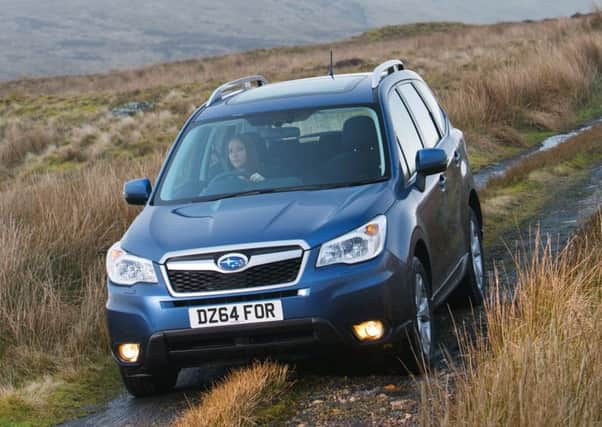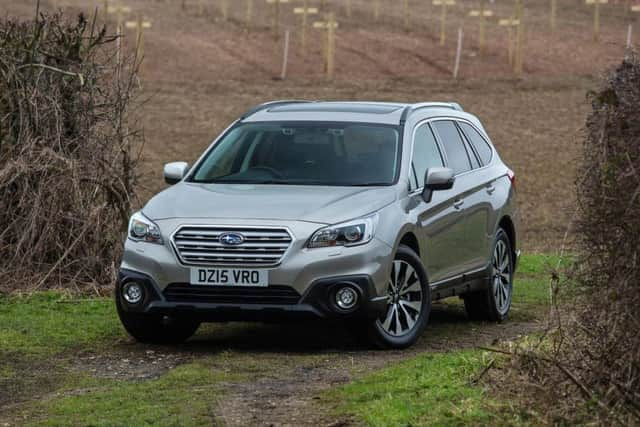Dependable duo will keep Subaru diehards happy


There’s a frankness about a Subaru press presentation, an acceptance that it is a niche player and unlikely to reach beyond 4,000 UK sales a year in the near future.
Paul Tunnicliffe, head of brands at IM Group, which imports Subaru, says they appeal to people who live in a rural environment and want “exceptional” all-wheel-drive in a rugged durable and unpretentious vehicle. Just the job for the Highlands, but townies may find something they like, too. Marque sales stormed ahead by 27 per cent in the first six months of this year.
Advertisement
Hide AdAdvertisement
Hide AdTwenty years ago the Japanese brand was famous for its ultra quick all-wheel-drive saloons. They won rallies, bewitched boy racers and were a favourite police pursuit car. A friend with one found himself racing a police Subaru which had been “after him” for weeks. I gather no summons changed hands. These days owners get legal thrills by competing in events like Knockhill’s Super Lap Scotland.


You can still get an Impreza turbo, now called the WRX STI. The catalogue also includes the BRZ, a rear-wheel-drive two seater Subaru also builds for Toyota. There’s the XV, a capable all-roading hatchback. But you’ll not see many of any of these.
Subaru’s core models are the Outback and the Forester, a couple of all-wheel-drive, higher-riding estate cars. The Outback, the larger of the pair, has just had a serious re-work. The Forester carries on with a milder revamp.
They are capable of tackling slippery grassy slopes and moderate farm tracks and snow, equipped with a very effective 4x4 system fed from either a diesel or petrol engine – with an old-fashioned layout. The four cylinders are laid out flat, a pair either side of the crankshaft. Of other maker, only Porsche retains this type of “boxer” engine, used in its sports models. The advantages are smoothness and a lower centre of gravity.
I’ve been driving the updated Forester XT with the Lineartronic six-speed automatic gearbox – which has continuously variable transmission ratios, aka CVT. The 2-litre petrol turbo delivers 237 bhp and a 0-62mph time of 7.5 seconds – quick enough to shrug off pushy tailgaters who think a Subaru estate is a slouch. At a fiver under £31,000, it’s top of the range, which starts at £25,495 for the 148bhp petrol XE, which has an “official” 41mpg and 160g CO2. The XT’s figures are 33mpg and 197g. It matched this figure in everyday driving and on a “commute” showed 37mpg. There’s also a 134bhp torquey 2-litre diesel from £24,995, returning 50mpg and 150g CO2. Sadly, I couldn’t love the navigation system.
A few days later and I am in the new Outback, bigger and comfier than the Forester. Subaru reckons it was the first of the “cross-over” cars 20 years ago. Since 2008 it has had a boxer diesel engine. This latest Outback has a new chassis and is a massive 67 per cent stiffer, which doesn’t flatter the old one, and steering wheel vibration is reduced 53 per cent. The steering response is quicker and the suspension has been overhauled and its standard tyres are now summer rubber. The 173bhp petrol engine has 80 per cent modified parts and the 148bhp diesel (also used in Forester) has had similar improvements.
Inside, wind noise is reduced by 6 per cent and road noise by 15 per cent. There is more shoulder room in a slightly larger body and the larger screen satnav is bearable but still fiddly.
It’s a nicer drive than the Forester and it introduces to Subaru automatic safety braking – called Eyesight, available only with the Lineartronic gearbox. Unlike other systems which use radar to detect an imminent crash, Eyesight uses stereo cameras mounted at the top of the windscreen. It detects cyclists, pedestrians and other vehicles but may not detect something less than a metre high – so watch out for wandering sheep on unfenced roads.
Advertisement
Hide AdAdvertisement
Hide AdThe system first gives a visual warning, then an alarm and starts braking. It will stop the car completely. Whether you make contact depends on speed and distance. It also stops the car from being driven over a kerb in a parking bay by disabling the throttle – useful if you are a messy parker. The car came out top in its class in a high-speed swerve, the so-called elk avoidance test.
Prices start at £28,495. Who buys them? The Forester and Outback are like slightly taller estate cars with the advantage of 4x4 drive. They are not as noticeable as, say, an Audi Q5, but this low-profile image actually suits its customers, who have no need to display their genes.
Verdict: Capable country wheels which appeal to modest country folk who may be able to afford a Range Rover but like the muted image of their Subaru and tend to keep them for years and then buy another. Here in September: The replacement for the Legacy estate, called bizarrely the Levorg GT.